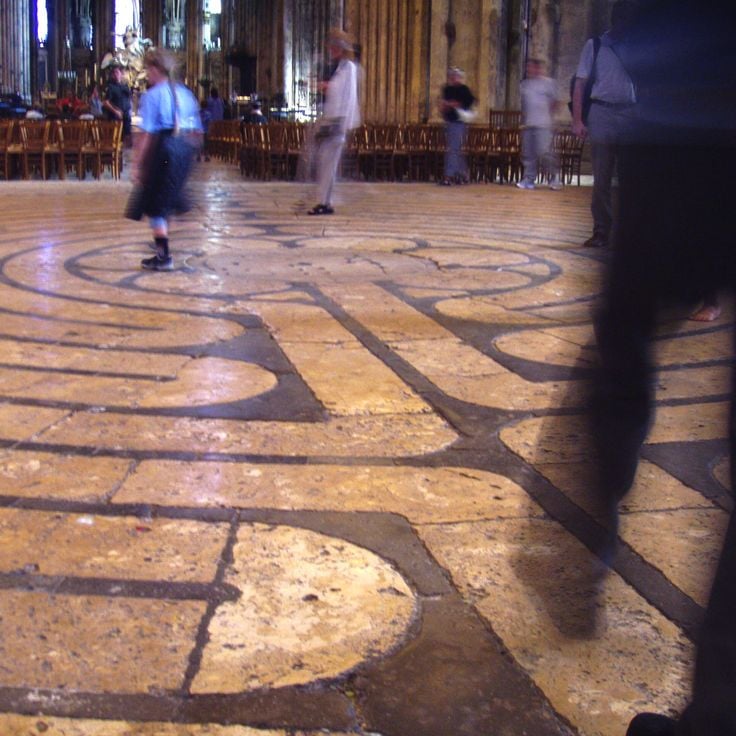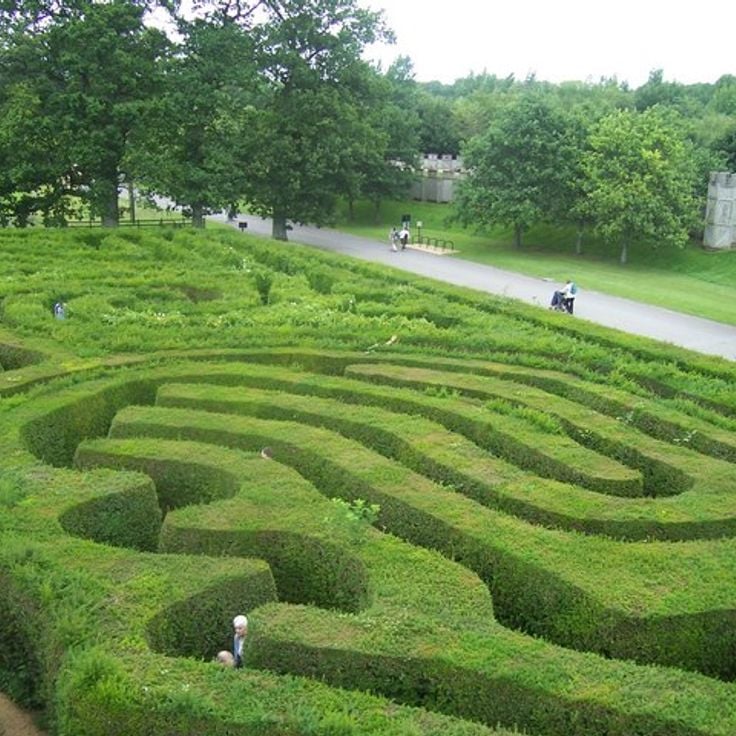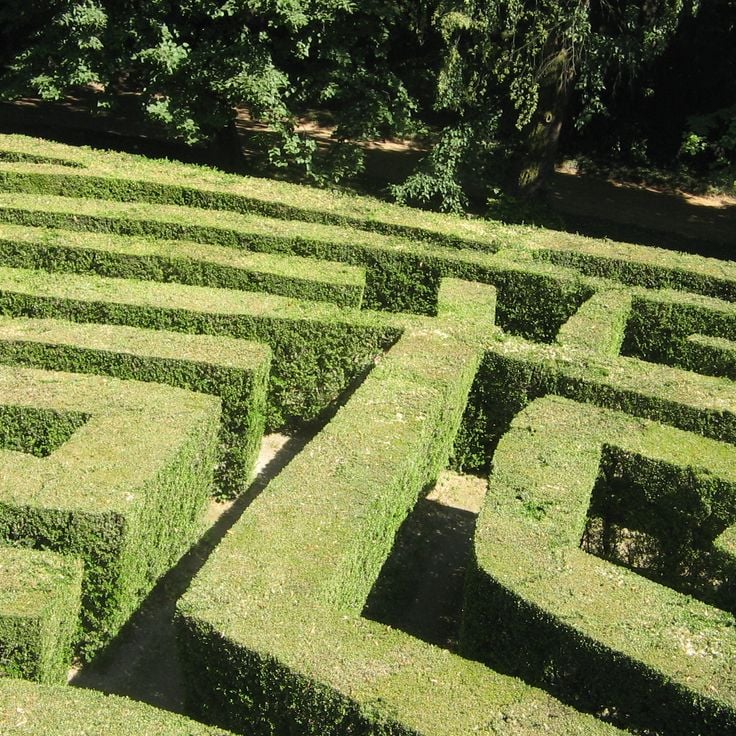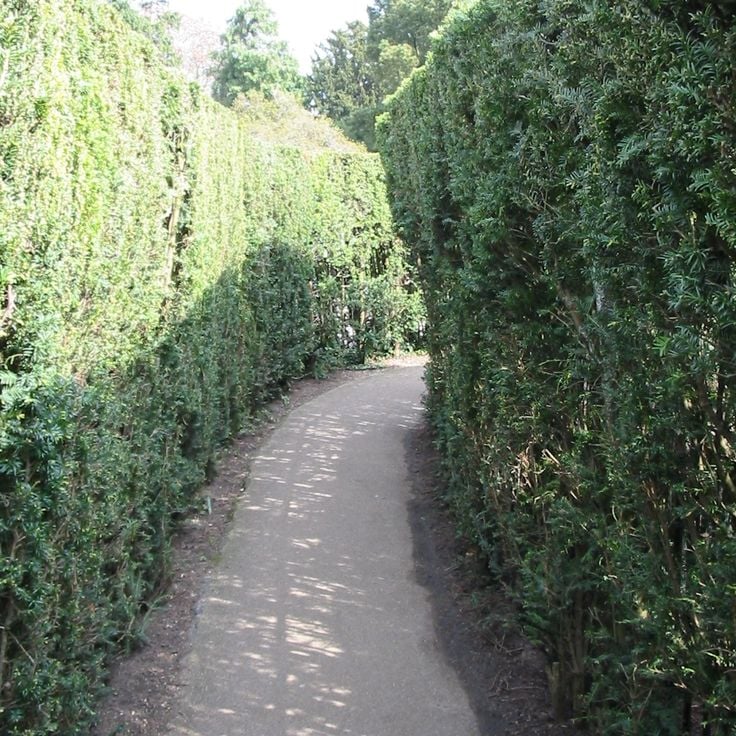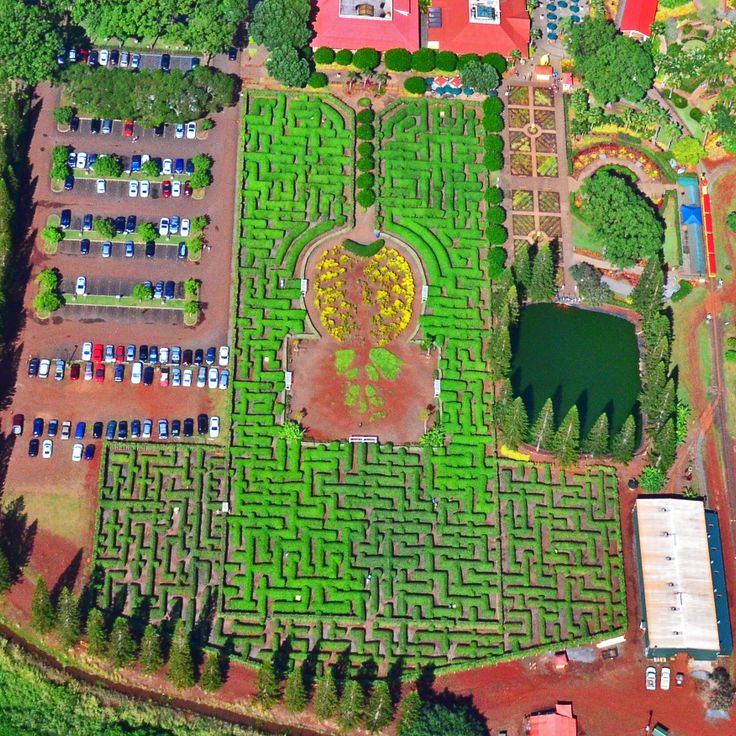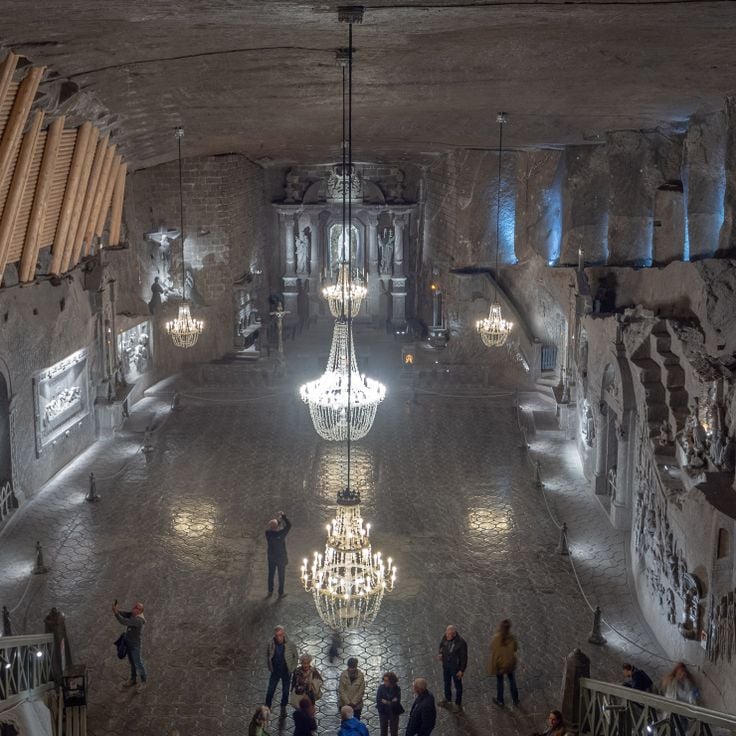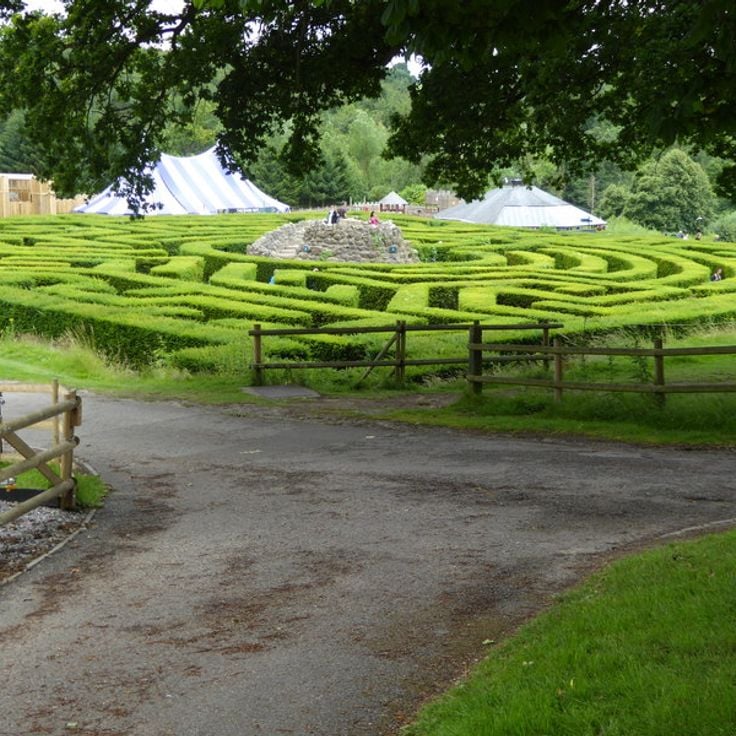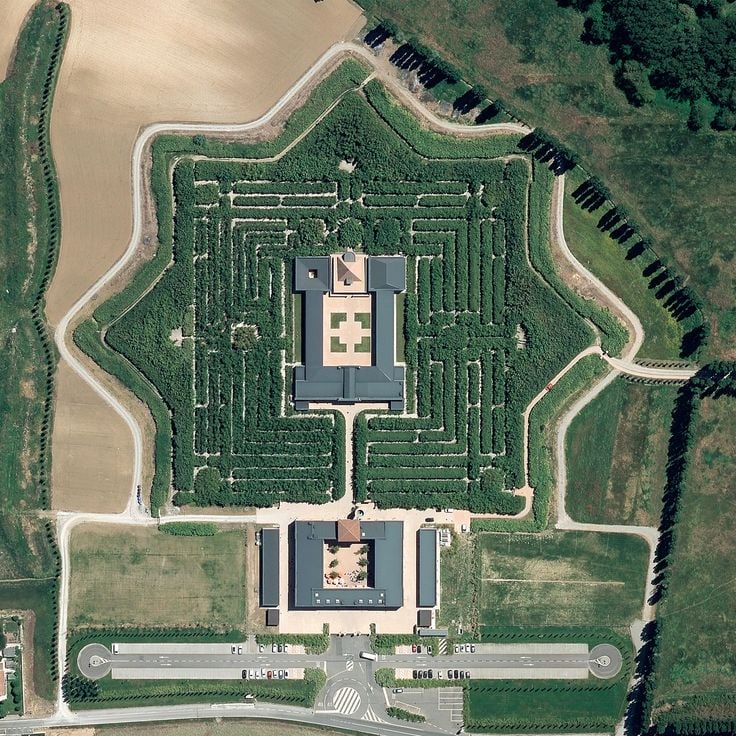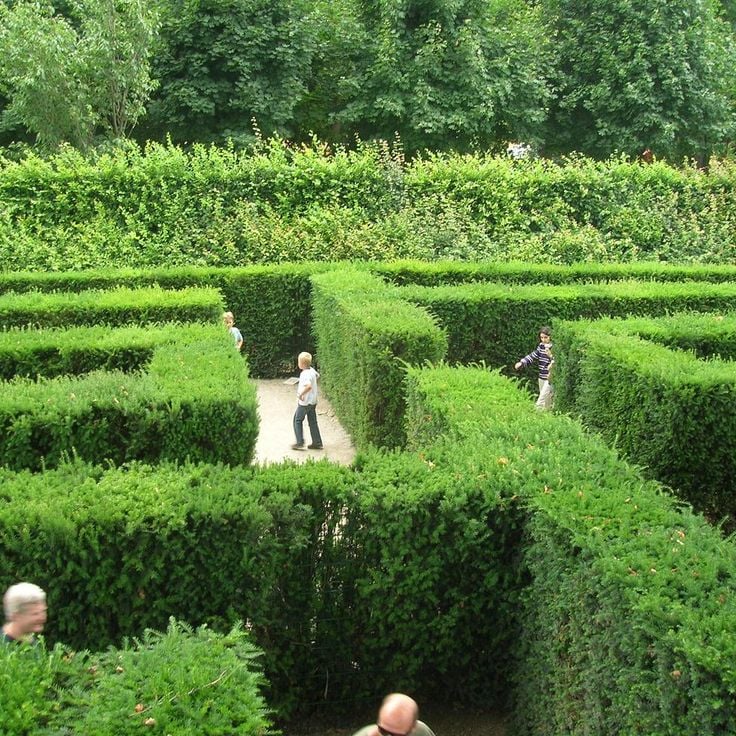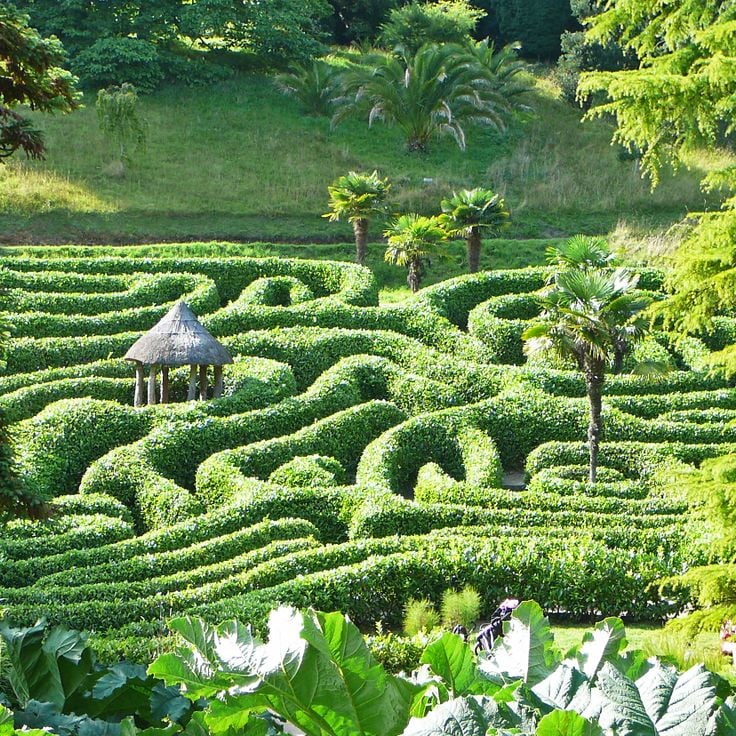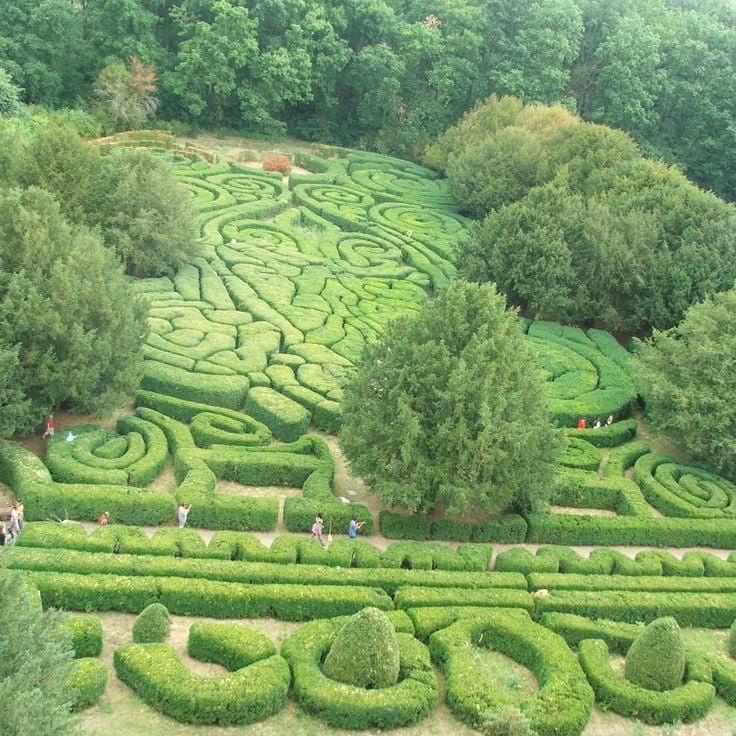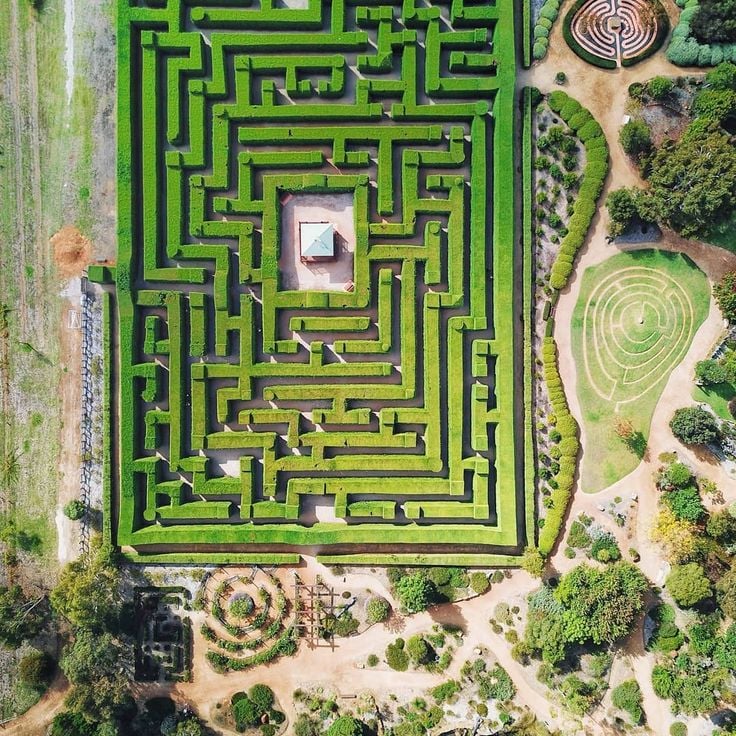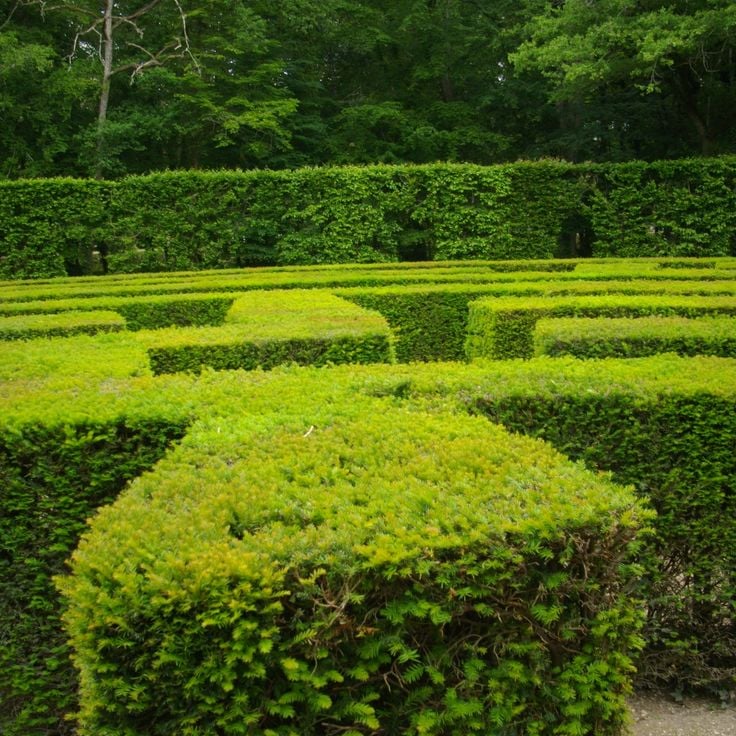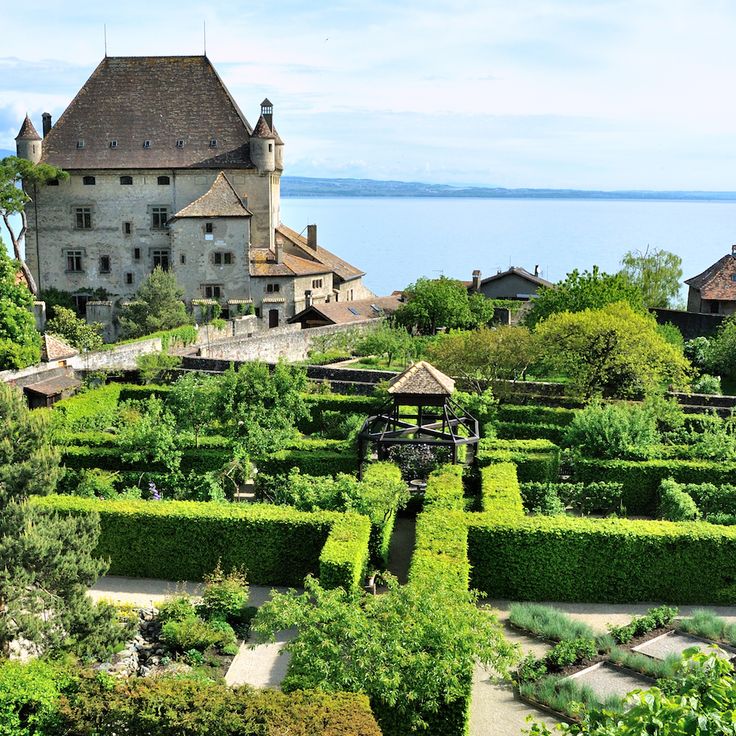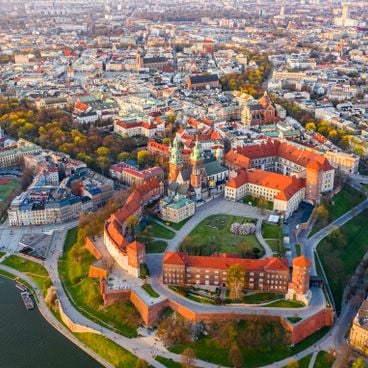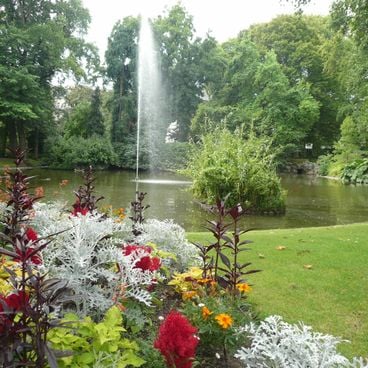Labyrinths have been part of human architecture for thousands of years, serving religious, meditative, and decorative purposes. Chartres Cathedral preserves one of the most famous medieval floor mosaics in Europe, guiding pilgrims along a 13-meter-wide path made of blue and white stones. English castles like Hampton Court developed hedge mazes from the 16th century onward as part of their formal gardens, while Italian Renaissance villas integrated geometric stone patterns into their terraces. The collection also includes underground structures such as the Paris Catacombs, whose winding passages were originally quarries, or the Roman cisterns of Istanbul with their rows of columns. Each era and region developed its own techniques: medieval stonework in cathedrals, baroque garden architecture with trimmed hedges, or pre-Columbian temple complexes with ritual pathways. These sites document various construction methods, from laying colored stone mosaics to creating multi-level garden courses to constructing underground vaults. They offer insights into historical craftsmanship and the symbolic meaning of the labyrinth across different cultures.
The Chartres Cathedral Labyrinth is one of the most significant floor mosaics featured in this collection of labyrinths across human architecture. This 13th-century labyrinth spans the floor of the central nave and measures roughly 13 meters in diameter. The design features alternating black and white stone slabs arranged in a complex geometric pattern. The path winds through eleven concentric circles over approximately 260 meters before reaching the center. Pilgrims have traditionally used this route as a symbolic journey to Jerusalem, walking it on foot or on their knees.
The hedge maze at Longleat House is part of this collection of labyrinths that have shaped human architecture for thousands of years. Planted in 1975 with approximately 16,000 English yew trees, the maze forms winding paths through dense hedges. Visitors walk through this green labyrinth searching for its center. The garden demonstrates how English country houses from the 16th century onward developed hedge mazes as part of their formal garden design, much like medieval cathedrals created stone mosaics or Italian Renaissance villas integrated geometric patterns into their spaces.
The Villa Pisani Labyrinth belongs to a collection that traces how labyrinths have shaped human architecture across cultures and centuries, from medieval cathedral floors to underground passages. This hedge maze was created in the 18th century for the Venetian noble Pisani family and consists of tall boxwood hedges forming a complex network of paths. At the center stands a two-story tower with a spiral staircase, from which visitors can observe the entire maze below. The symmetrical design extends over nine concentric rings and was modeled after French garden traditions. The villa itself is a Baroque palace located along the Brenta Canal, showcasing how Italian Renaissance estates integrated elaborate garden design into their landscape architecture.
The Horta Labyrinth Park demonstrates how gardens in the late 1700s used pathways as artistic elements. This park in Barcelona was created in 1794 and blends Italian and French landscaping traditions. At its center, 750 meters of cypress hedges guide visitors toward a statue of Eros. Along the winding paths stand sculptures of Greek deities such as Ariadne and Dionysus. The upper section features a romantic garden with waterfalls and channels, while the lower terraces follow a strict neoclassical geometric pattern, showing the orderly designs that were central to European garden architecture of that era.
The Hampton Court Palace Maze exemplifies baroque garden design from the late 17th century and demonstrates how English royal estates integrated these complex structures into their formal gardens. Commissioned by King William III of Orange in 1690, this yew hedge maze occupies half an acre within the royal gardens. The trapezoidal design features 800 meters of winding paths bordered by hedges that grow up to two meters high. A raised platform at the center allows visitors to survey their route. This maze became a model for numerous other garden labyrinths across Europe and illustrates the construction methods and garden craftsmanship of the baroque period.
The Dole Plantation Maze on Oahu is part of this collection of labyrinths from different cultures and periods throughout history. Covering two hectares, this maze incorporates over 14,000 native Hawaiian plants. The winding paths pass through sections of pineapples, hibiscus, and heliconias that represent the tropical ecosystem of the islands. Visitors explore various botanical collections while navigating the geometrically designed pathways.
The Peace Maze at Castlewellan Forest Park stands as a modern expression of humanity's long tradition of creating labyrinths, built from 6000 yew trees planted by the local community. Like the hedge mazes developed in English castle gardens and the stone floor mosaics of medieval cathedrals, this labyrinth demonstrates how different periods and cultures have shaped pathways into symbolic forms.
Wieliczka Salt Mine forms an underground labyrinth with nine levels extending up to 327 meters below the surface. This salt mine operated from the 13th century until 2007 and comprises 287 kilometers of tunnels and chambers carved entirely in rock salt. Over the centuries, miners created chapels, sculptures and reliefs directly in the salt. The underground chambers contain lakes of saline water and display the geological layers of the mineral.
The Leeds Castle Maze in this collection demonstrates how English castles integrated hedge mazes into their formal gardens from the 16th century onward. This maze consists of 2400 yew trees arranged in a circular pattern across the grounds. At the center lies an underground grotto serving as a distinctive destination for visitors. The dense yew hedges create winding pathways that guide explorers through the historic estate, showing how horticultural design combines with the castle's architecture and landscape.
The Labirinto della Masone in Parma covers eight hectares and is the largest bamboo labyrinth in the world. Franco Maria Ricci commissioned the construction between 2005 and 2015. More than 200,000 bamboo plants of different species form the walls of the winding pathways. Inside is a cultural center displaying artwork from the 16th century to today. A library holds about 15,000 books documenting the history of labyrinths and related topics. The site includes a restaurant and exhibition spaces. This labyrinth shows how contemporary garden design creates a large-scale version of this ancient form, fitting into the collection of labyrinths from different periods and cultures around the world.
The stone labyrinths of Bolshoy Zayatsky Island are part of a global collection of labyrinths that have served religious, meditative, and decorative functions throughout human history. This White Sea island holds 35 prehistoric structures built during the first millennium BC. The labyrinths consist of flat stones arranged in low walls that form concentric or spiral patterns. The spiral formations range from 6 to 20 meters in diameter. Archaeologists believe these installations served ritual or astronomical purposes, showing how early cultures incorporated these forms into their landscapes.
This labyrinth contributes to the collection by showing how modern garden design adapts the maze concept for today's visitors. The corn maze extends across roughly 11 kilometers of pathways that are redesigned each year around a new theme. Visitors encounter puzzles and games designed to test navigation skills and provide entertainment. Each year brings a different pattern, offering varied challenges for families and groups.
The hedge maze at Schönbrunn Palace is a geometric labyrinth with winding paths set between trimmed hedgerow walls where visitors can explore. From an elevated platform, visitors can see the pattern of the maze from above and understand how the pathways are arranged. The Palace maze was rebuilt following historical plans from the 18th century and is now part of the baroque garden complex. Like other labyrinths in this collection, Schönbrunn Palace demonstrates how different regions and time periods developed their own techniques, showing baroque garden architecture with trimmed hedges that documents human craftsmanship and the symbolic meaning of labyrinths across cultures.
The maze at Glendurgan Garden was created in 1833 within a subtropical valley in Cornwall. It forms part of a collection documenting labyrinths across cultures and centuries - from medieval stone mosaics in cathedrals to underground structures like the Paris Catacombs. Dense cherry laurel hedges shape the pathways and have grown to their present height over nearly two centuries. The winding paths lead to a small thatched hut at the center, which serves as a resting place for visitors after they have navigated the intricate passages.
Ashcombe Maze is part of a worldwide collection of labyrinths found in churches, gardens, and underground structures. This garden labyrinth in rural Shoreham on Victoria's Mornington Peninsula shows how the labyrinth tradition survives in modern garden design. Ashcombe Maze consists of two hedge mazes made from Monterey cypress trees with walls of dense green foliage. The winding paths create geometric patterns that visitors navigate. Adjacent to the mazes are lavender fields that bloom from November to January. The garden combines horticultural design with traditional maze architecture, inviting visitors to explore the structured pathways while experiencing the surrounding plantings.
The Richardson Adventure Farm Corn Maze in Illinois demonstrates how modern farming continues the ancient tradition of labyrinths. This seasonal cornfield maze extends across farmland with pathways that guide visitors through different difficulty levels and checkpoints. The farm designs new patterns and themes each year for the maze, which operates during the fall season. Like the stone mosaics of Chartres Cathedral and the hedge mazes of English estates, this maze shows how the labyrinth concept remains alive from ancient structures to contemporary recreation.
The maze in the gardens of Andrássy Castle was created in the 19th century as part of the estate's landscaped grounds. The pathways form geometric patterns bordered by boxwood hedges, designed according to historical garden principles. This maze demonstrates how European aristocratic estates integrated geometric patterns into their formal gardens, continuing a tradition established at Hampton Court. The labyrinth remains an important feature of the property's garden architecture from this era.
The Margaret River Maze is a labyrinth of geometrically arranged hedges that stands within this collection as an example of modern garden maze architecture. The winding paths pass through native plants and covered passages, echoing baroque garden design with trimmed hedges. The layout is divided into different thematic sections that offer visitors varied exploration experiences. The design combines natural vegetation with structured elements and provides reference points along the meandering routes.
The Chenonceau Maze is part of the collection of world labyrinths, showing how Renaissance gardens at the chateau featured hedge mazes with geometric patterns. Yew trees form winding pathways that visitors walk through, creating an engaging garden experience. This maze demonstrates how 16th-century European estates incorporated labyrinthine designs into their formal gardens for both decoration and contemplation.
The Five Senses Garden Maze at Yvoire Castle organizes its pathways around thematic sections, each engaging one of the five senses. Visitors walk through areas with aromatic herbs for smell, plants with varied textures for touch, colorful flowers for sight, and water features providing sound. The garden follows a medieval design approach and shows how historical garden architecture, like the labyrinthine paths in this collection, creates structured journeys through space that serve both practical and contemplative purposes.
Lands End Labyrinth shows how modern installations carry forward the ancient labyrinth tradition. This collection documents labyrinths from different eras and cultures, ranging from medieval stone mosaics in cathedrals to hedge mazes in English castles. Lands End Labyrinth fits into this global context: its concentric stone circles perched on a cliff above the Pacific Ocean combine classical labyrinth design with modern use as a meditation space. The stone pathways guide visitors inward to the center, much like the 13-meter-wide paths in Chartres Cathedral once guided pilgrims. This labyrinth demonstrates how people across thousands of years have created these forms for spiritual and reflective purposes.
The labyrinth of Amiens Cathedral was built into the floor of the nave in the 13th century. This stone pathway measures roughly 12 meters across and guides visitors through 13 turns from the entrance to the center. Black and white stones create a geometric pattern that functioned as a spiritual pilgrimage route. Believers walked this path on their knees as a symbolic journey to Jerusalem. The labyrinth at Amiens Cathedral is one of the surviving medieval examples of this liturgical tradition in French cathedrals and shows how craftsmen created spaces for spiritual reflection.
The Saffron Walden Labyrinth is a medieval turf maze located on the Village Green, featuring a classical spiral design. A single winding path guides visitors from the outer entrance to the central point through concentric rings arranged in a traditional pattern. This maze ranks among the largest surviving examples of its kind in England and shows the early techniques used to create garden labyrinths that would later develop in formal gardens and important cultural sites.
